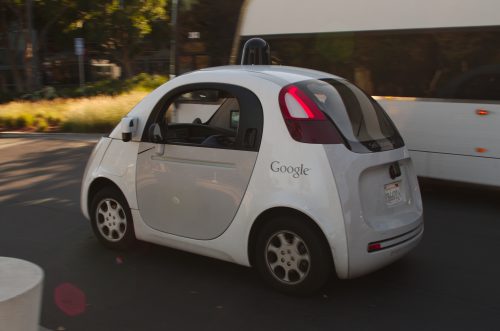Driverless cars will not rest for a moment, so they may serve as a universal and cheap means of transportation.

by David Fogg, The article is published with the approval of Scientific American Israel and the Ort Israel network 27.09.2016
There is no doubt that driverless cars are a hot news topic. Already today, components for partial automation of driving are integrated (or will be integrated in the near future) in a long line of models: Honda, Volvo, General Motors, Ford, Audi, Mercedes, Tesla and more. These cars offer smart cruise control that works up to a speed of zero km/h, meaning they are able to drive automatically in traffic jams, braking and accelerating the car and avoiding collisions. They can pass a lane, or stick to a certain lane, as you choose. They can park the car parallel to the sidewalk or perpendicular to it. Almost the only thing they are not able to do alone is to make turns at intersections.
The symbol of all driverless cars is of course Google's fleet of cars. These cars have driven themselves for a cumulative distance of more than a million miles on public roads. During this driving, only one accident occurred for which the autonomous vehicle was partially responsible (Bus collision in February 2016).
It's an exciting business. Driverless cars will be able to prevent the traffic accidents that kill 1.2 million people worldwide every year. It will be possible to save the expenditure of trillions of dollars on hospitalization days and insurance payments.
But the use of vehicles in the future is intended to advance far beyond replacing our "stupid" private cars with autonomous cars. Instead, imagine a world where driverless cars that we don't own drive the roads. Robotic cars that you only order when you want to drive.
Some huge companies are investing huge sums in realizing this vision. In February 2015 The people of the Uber company raided On the prestigious robotics department at Carnegie Mellon University and invited 40 of the senior researchers in the department to move to work in the service of the company.
In January 2016, General Motors invested half a billion dollars in a company competing with Uber, Lift Her name, with the aim of developing its own driverless cars, which will operate on demand. Ford and Google plan to join forces for a similar purpose. Yes, driverless cars are revolutionary. But driverless cars on demand? The changes they will bring will be so far-reaching, fast and global that there will be nothing related to day-to-day transportation that will not change - and for the better, for the most part.

The idea of using inexpensive robotic transportation leads to the conclusion that there would be no particular reason to own a car. You will not have to purchase it, maintain it or fuel it. You will never be late because you had to remove frost from the windshield or shovel snow from the entrance to the home parking lot.
When you order a robotic car you won't have to wait for it to warm up in the winter (or cool down in the summer). You will never look for parking. The car will simply drop you off at the entrance to the destination and continue flying on.
And perhaps the social structures designed to protect us from bad drivers will become redundant: speed limits, speeding reports, separation fences and even car insurance.
And by the same token, who would need driving lessons or a driver's license? 12-year-old children will be able to get a ride home alone after staying with friends. And it doesn't matter if you (or your parents) are too old, weak or sick to drive. Millions of people confined to their homes will be freed.
Drunk drivers? No problem, if you don't drive you can drink! Tired of a long drive? The robotic taxi will drive all night while you doze off. Teens? Send text messages to your heart's content!
There is no doubt that there are still many, many details that need to be taken care of. Some of them are technical; Most of the driverless cars operating today get confused when it snows, for example, and do not understand what the human policeman who directs the traffic wants from them. Some of the problems are more distant, although they are also important: Will robotic taxis be immune from hackers? If they cause an accident, who will be responsible? The car owner? The car manufacturer? Or the software company? And what about losing jobs? Taxi drivers, bus drivers, and even Uber and Lyft drivers.
And if you prefer to drive yourself, that option is still open to you. Meanwhile, some experts predict that driverless cars will be a common sight on the roads within five years. It's time to prepare for the new era without drivers. It's too late to cross a lane.
about the writer
David Fogg - Senior columnist for Yahoo Tech and hosted several short series on NOVA and PBS.
More on the subject on the science website
The truth about driverless cars, Steve A. Sheldover (Scientific American Israel)

3 תגובות
citizen
Regardless of the fact that, in my opinion, it will take several good decades before the described vision is realized. The points you made are really interesting. It probably wouldn't really be an option to install cameras that would point inward into the vehicle. Which of course will create privacy issues.
Another option I thought about is a camera that will be activated at the end of the trip after passengers have disembarked. And with the help of an analysis of the image, you will understand whether the vehicle is clean or not (in my opinion, this is a relatively simple task for royal intelligence, and this will be possible until autonomous cars are common. All that is needed is a comparison to a photo of a clean vehicle) if the vehicle is not clean, the vehicle will tell the passengers and give them an opportunity to clean (In case it's just some snack wrappers) this time will still be at the expense of the counter. If the customers don't want to or won't be able to clean. The car will go to the wash and charge the passengers. (Of course, the trip will only be possible with a credit card so that it will be possible to charge for damages if there are any)
Perhaps there will also be a premium taxi service for the rich with larger vehicles and with a taxi boy (about the weight of an elevator boy) he will sit in the front but will not drive but will load the bags open the doors and enter the travel destination into the computer. Of course such a taxi will always be cleaner.
There may also be rich people who insist on owning a privately owned car, but they will be rare.
citizen
Regardless of the fact that, in my opinion, it will take several good decades before the described vision is realized. The points you made are really interesting. It probably wouldn't really be an option to install cameras that would point inward into the vehicle. Which of course will create privacy issues.
Another option I thought about is a camera that will be activated at the end of the trip after passengers have disembarked. And with the help of an analysis of the image, you will understand whether the vehicle is clean or not (in my opinion, this is a relatively simple task for royal intelligence, and this will be possible until autonomous cars are common. All that is needed is a comparison to a photo of a clean vehicle) if the vehicle is not clean, the vehicle will tell the passengers and give them an opportunity to clean (In case it's just some snack wrappers) this time will still be at the expense of the counter. If the customers don't want to or won't be able to clean. The car will go to the wash and charge the passengers. (Of course, the trip will only be possible with a credit card so that it will be possible to charge for damages if there are any)
Perhaps there will also be a premium taxi service for the rich with larger vehicles and with a taxi boy (about the weight of an elevator boy) he will sit in the front but will not drive but will load the bags open the doors and enter the travel destination into the computer. Of course such a taxi will always be cleaner.
There may also be rich people who insist on owning a privately owned car, but they will be rare.
It will have many advantages but also disadvantages that will have to be overcome because the devil is in the small details,
One of the examples of a "shared" vehicle fleet is in kibbutzim where you enjoy the advantages such as the fact that you don't mess around
In a licensed garage and everything that happens around the maintenance of the vehicle, the second advantage is a much better utilization of the vehicle
It's like how many people share the price of one car, (something that can be unpleasant for the car companies),
And now for the disadvantages in a private car that you return late for example with the children the next morning you will clean up the mess
This doesn't always happen in the kibbutz car, here you are at the mercy of those who drove before you and in the kibbutz there is some hint of caring, you can still find who was in front of you, there is a car attendant, etc... What will happen to an automatic car in the city without the ceremonial driver who looks after the car? In a place where the bond between the people is smaller than the kibbutz, it's not your car that the company will clean all the same phenomena that exist in the kibbutz will be intensified to crazy degrees in the city,
For example, a group of young people who smoke come back after spending time vomiting, throwing bottles, cigarettes, putting them out by padding snacks and all kinds of other means, used underwear, etc... In the kibbutz they will be outnumbered and they may have to spend a few months on the bus, but how will the city control this, there will be solutions, but it's more complex...
And also families in the car eating diapers with Bamba thrown on the floor
A family returns from the beach, the whole floor is full of sand, mud, the chairs are wet
It is enough once a day that something comes in that consideration of others is not part of his regular repertoire
And this vehicle turns from a dream of robotic progress into a nightmare that takes you back to the biological swamp,
These are not small things, these are a very difficult problem in an automatic public vehicle, they will have to find solutions for this,
Probably not only cameras on the outside but also on the inside to keep an eye on the wild hominids,
Another problem is of course the availability, which is by and large 100% with a private car and is conditional with a robotic vehicle
Because during rush hours, like taxis, it is likely that there will be a shortage of vehicles like the collective vehicle fleet
You are forced to exchange the spontaneity of Yala where we will plan in advance which guarantees you that there will be a car on the designated day and time
, it can be estimated that more problems will be discovered,